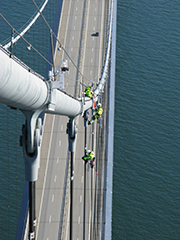
Background
For many of the world’s large cable-supported bridges incidents have been reported where some the stay or hanger cables exhibit large-amplitude vibrations under certain climatic conditions in connection with wind. These phenomena are not only disturbing and unsettling for the bridge traffic but also cause significant fatigue effects at anchors, connection plates and in the cable itself. When designing a new cable-supported bridge these issues have to be considered in particular – the question is how. The intense research over the last decades has increased the knowledge regarding the instability phenomena and new improved concepts for bridge cable design have been developed. And yet, many questions are still unanswered and many cables continue vibrating in spite of all achievements.
Our Approach
To conduct research on this issue a special Climatic Wind Tunnel (CWT) facility was built, jointly designed an operated by the Technical University of Denmark (DTU), Department of Civil Engineering and FORCE Technology, Department of Hydro and Aerodynamics. A particular feature of the CWT is its capability of creating real ice accretion. The general condition for which ice accretion is simulated is best described as atmospheric icing in supercooled clouds at low altitude. Supercooled clouds consist of liquid water droplets significantly below their nominal freezing point.

Simulation of ice accretion on full-scale bridge cable segments. So far, for icing only flow normal to the cable axis and without vibration has been investigated. For fall 2012 test cases with inclined cables and free vibration are enviaged.
The facility was commissioned in spring 2010. After a run-in phase and the development of suitable test setups numerous experiments on dry cables have been performed looking for particular effects of cable surface textures on the flow-induced forces and moments. Alternating with the ongoing tests series on dry and wet cables the cooling and spray system of the wind tunnel was tested and refined to allow some first tests on the effect of ice accretion on the flow-induced forces on a cable section. Some first systematic investigations of the effect of ice accretion on the aerodynamic forces of bridge cable sections have been conducted. The bulk part of the work on icing research in the CWT is facility development and refinement:
-
Optimisation of spray bar design.
-
Control and adjustment of air temperature.
-
Measurement and adjustment of droplet size and distribution.
-
Testing of measurement equipment and experimental setup under icing conditions.
-
Performance of icing tests with simultaneous measurement of forces.
- Documentation of ice accretion growth and shape characteristics.

Works and publications relating to atmospheric icing research in CWT
Kermani, A.K., 2012. Development of aerodynamic loads under icing of bridge cables. M.Sc. Project, Supervisor: Holger H. Koss, Industry partner: FORCE Technology, Department of Hydro and Aerodynamic
Koss, H. and Matteoni, G., 2011. Experimental investigation of aerodynamic loads on iced cylinders. Proceedings of 9th International Symposium on Cable Dynamics, Shanghai, China, 2011
Bajric, A. and Holmen, C., 2011. Simulation of ice accretion on bridge cable. B.Sc. Project, Supervisor: Holger H. Koss, Industry partner: FORCE Technology, Department of Hydro and Aerodynamic